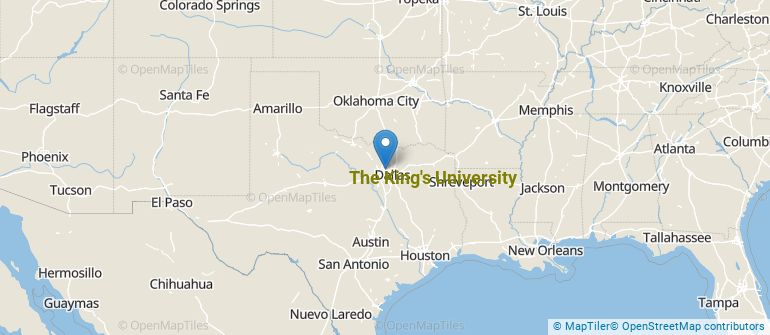 by our College Data Analytics Team
by our College Data Analytics TeamExplore the best ranked schools for the programs you are most interested in.
TKU was not ranked in College Factual's Best Overall Colleges report this year. This may be because not enough data was available.
With an acceptance rate of 94%, The King's University is easier to get into than many other schools. But that doesn't mean you can slack off on your application. Make sure to treat this school like any other when submitting requested materials and documents.
About 44% of students accepted to TKU submitted their SAT scores.TKU received ACT scores from 11% of accepted students.
The student to faculty ratio at TKU is an impressive 10 to 1. That's quite good when you compare it to the national average of 15 to 1. This is a good sign that students at the school will have more opportunities for one-on-one interactions with their professors.
In addition to the student to faculty ratio, some people look at what percentage of faculty members are full-time as a sign of how much time professors will be able to spend with their students. This is because part-time teachers may not be be on campus as much as their full-time counterparts.
The full-time faculty percentage at The King's University is 100%. This is higher than the national average of 47%.
The freshmen retention rate of 88% tells us that most first-year, full-time students like The King's University enough to come back for another year. This is a fair bit higher than the national average of 68%. That's certainly something to check off in the good column about the school.
The on-time graduation rate is the percent of first-time, full time students who obtain their bachelor's degree in four years or less. This rate is 9% for first-time, full-time students at TKU, which is lower than the national rate of 33.3%.
Find out more about the retention and graduation rates at The King’s University.
During the 2017-2018 academic year, there were 319 undergraduates at TKU with 163 being full-time and 156 being part-time.
| $0-30 K | $30K-48K | $48-75 | $75-110K | $110K + |
|---|---|---|---|---|
| $20,002 | $22,575 | $18,905 | $25,835 | $23,958 |
The net price is calculated by adding tuition, room, board and other costs and subtracting financial aid.Note that the net price is typically less than the published for a school. For more information on the sticker price of TKU, see our tuition and fees and room and board pages.
Almost 66% of college students who graduated with the class of 2018 took out student loans, but that percentage varies from school to school. At TKU, approximately 60% of students took out student loans averaging $6,094 a year. That adds up to $24,376 over four years for those students.

See which majors at The King’s University make the most money.
Get more details about the location of The King’s University.

Contact details for TKU are given below.
| Contact Details | |
|---|---|
| Address: | 2121 E. Southlake Boulevard, Southlake, TX 76092 |
| Phone: | 817-722-1700 |
| Website: | https://www.tku.edu/ |
| Most Popular Majors | Bachelor’s Degrees | Average Salary of Graduates |
|---|---|---|
| Theological & Ministerial Studies | 64 | $29,593 |
| Mental & Social Health Services | 14 | NA |
| Pastoral Counseling & Specialized Ministries | 8 | NA |
| Sacred Music | 7 | NA |
| Theology & Religious Vocations (Other) | 6 | NA |
| Design & Applied Arts | 6 | NA |
| Missionary Studies | 2 | NA |
Online learning options are becoming more and more popular at American colleges and universities. Online classes are great for students who have busy schedules or for those who just want to study on their own time.
In 2022-2023, 406 students took at least one online class at The King's University. This is a decrease from the 491 students who took online classes the previous year.
| Year | Took at Least One Online Class | Took All Classes Online |
|---|---|---|
| 2022-2023 | 406 | 290 |
| 2021-2022 | 491 | 295 |
| 2020-2021 | 488 | 263 |
| 2018-2019 | 460 | 213 |
Footnotes
*The racial-ethnic minorities count is calculated by taking the total number of students and subtracting white students, international students, and students whose race/ethnicity was unknown. This number is then divided by the total number of students at the school to obtain the racial-ethnic minorities percentage.
References
More about our data sources and methodologies.